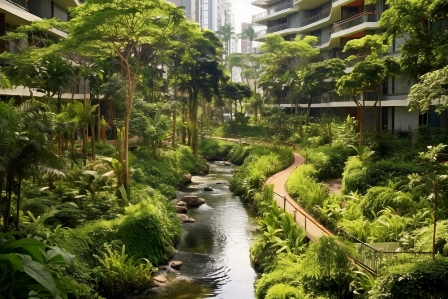Are you tired of spending countless hours and resources on maintaining a traditional garden that constantly thirsts for water? It’s time to explore the beautiful world of xeriscaping, where you can create a stunning garden while conserving water. In this comprehensive guide, we will delve into “The Art of Xeriscaping: Creating Beauty with Drought-Resistant Plants.” Join us on this journey to discover how you can transform your outdoor space into an oasis of greenery that not only survives but thrives in drought conditions.
The Basics of Xeriscaping
Xeriscaping is more than just a landscaping trend; it’s a sustainable gardening philosophy that embraces the use of drought-resistant plants, efficient watering techniques, and creative design. By implementing xeriscaping, you can significantly reduce your water consumption and still enjoy a vibrant garden. Let’s explore the fundamentals of xeriscaping:
Drought-Resistant Plant Selection
Choosing the right plants is the cornerstone of xeriscaping. Opt for native or adaptive species that thrive in your region, requiring minimal watering. Examples include succulents, ornamental grasses, and desert wildflowers.
Efficient Watering
Xeriscaping involves smart watering methods such as drip irrigation and soaker hoses. These techniques ensure that water reaches the plant roots directly, reducing waste and evaporation.
Soil Improvement
Amending your soil with organic matter improves its water retention capacity. Well-prepared soil enables your plants to access moisture more efficiently.
Creative Design
Xeriscaping encourages artistic landscape design. Incorporate elements like gravel paths, decorative rocks, and strategically placed boulders to create a visually appealing garden.
Mulching
Mulch acts as a protective layer, conserving soil moisture, preventing weed growth, and maintaining a stable soil temperature.
Xeriscaping: A Gift to the Environment
Xeriscaping isn’t just about reducing your water bill; it’s also a gift to the environment. By implementing xeriscaping in your garden, you are contributing to the conservation of local ecosystems and resources. Here’s how:
Water Conservation
Xeriscaping can reduce water consumption by up to 60%. This not only saves money but also preserves this precious resource for future generations.
Habitat Preservation
Native plants used in xeriscaping create natural habitats for local wildlife, from birds to pollinators. Your garden becomes a haven for biodiversity.
Reduced Chemical Usage
With healthier plants and balanced ecosystems, there’s less need for pesticides and fertilizers, reducing chemical runoff into water sources.
Lower Maintenance
Xeriscaping requires less maintenance than traditional landscaping, which means fewer emissions from lawnmowers and trimmers.
The Art of Xeriscaping: Creating Beauty with Drought-Resistant Plants
The beauty of xeriscaping lies in its adaptability to various climates and landscapes. Whether you live in a dry desert or a region with sporadic rainfall, xeriscaping allows you to create a garden that’s uniquely yours. Here’s how you can master the art:
Plant Selection
Research and select drought-resistant plants that thrive in your specific climate. Consider incorporating a variety of shapes, colors, and sizes to create an aesthetically pleasing garden.
Grouping and Zoning
Group plants with similar water needs together, creating efficient watering zones. This ensures that each plant receives the appropriate amount of moisture.
Seasonal Interest
Plan your xeriscape to have year-round appeal. Choose plants that bloom at different times, so your garden remains colorful throughout the seasons.
Hardscaping
Incorporate elements like decorative stones, pavers, and sculptures to add character to your garden. These non-living elements complement the natural beauty of drought-resistant plants.
Garden Edging
Use attractive edging materials to define garden beds and pathways. Edging not only enhances the visual appeal but also helps with weed control.
Maintenance
Xeriscaping doesn’t mean zero maintenance, but it certainly reduces the workload. Regularly check for weeds, prune plants, and adjust watering schedules as needed.
FAQs
A: Absolutely! Xeriscaping principles can be applied in various climates. You may need to choose plants that can handle occasional wet conditions and focus on water-efficient practices.
A: Xeriscaping can have an initial investment, but the long-term savings on water bills and maintenance costs often outweigh the upfront expenses.
A: Not at all. With careful plant selection and creative design, xeriscapes can be incredibly lush and colorful. They offer a unique, natural beauty.
A: Plant native flowers and shrubs that attract pollinators like bees and butterflies. These plants provide food and habitat for these essential creatures.
A: Absolutely! Xeriscaping is flexible and can be adapted to any garden size, from a small urban plot to a sprawling suburban landscape.
A: Some regions offer incentives or rebates for xeriscaping projects, as they contribute to water conservation efforts. Check with your local authorities.
Conclusion
Embracing “The Art of Xeriscaping: Creating Beauty with Drought-Resistant Plants” not only transforms your outdoor space into a stunning oasis but also contributes to the sustainable use of our precious water resources. With the right plant selection, creative design, and efficient watering techniques, you can enjoy a vibrant garden while conserving water and benefiting the environment. Get started on your xeriscaping journey today and make a positive impact on your surroundings.












Find Us on Socials